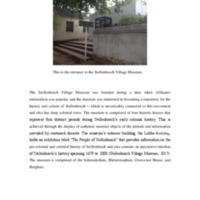Kayamandi/Central Stellenbosch: House museums
Title
Kayamandi/Central Stellenbosch: House museums
Subject
Investigating the semiotic landscape of the house museum in Stellenbosch, South Africa
Description
The research questioned what a comparative analysis of the semiotic landscapes of the Stellenbosch Village Museum and the Kayamandi Creative District House Museum reveal about the broader historical and sociocultural contexts wherein each exist, with the aim to ascertain the extent to which the museums are appropriate house museum models in a post-apartheid context. Social semiotics and the dual theory of museology and curatorship formed the theoretical framework for this study. I followed a qualitative approach within an interpretive paradigm and a comparative case study research design was used. The data in this study were collected mostly through individual interviews with management, staff, docents and homeowner-docents of the Stellenbosch Village Museum and the Kayamandi Creative District House Museum. Additional data were collected through individual interviews, workshops, observations, field visits, e-mail interview and correspondence, and document analysis.
The investigation revealed that the use of traditional museological practices, as mostly embodied by the Stellenbosch Village Museum, adds to the various deficiencies in inclusivity regarding the history and culture of Stellenbosch. Conversely, the use of new museological practices, as mostly embodied by the Kayamandi Creative District House Museum, could address this lack as the black, Xhosa history and culture it represents offers a balance to the white, colonial history of the town. The study found that in order for democratisation and decolonisation to occur, it is necessary that Stellenbosch’s museums embrace new, innovative museological practices that cater to local knowledge and previously marginalised communities. The study offers the Kayamandi Creative District House Museum as a potential new museological model that could assist in reducing differences and divisions in Stellenbosch’s sociocultural divide through the cross-cultural exchange of history and culture by and in the very community that the museum represents. This study aimed to contribute to the research field of museology and curatorship in a post-colonial and post-apartheid Stellenbosch context with the expansion of the dialogue on museological transformation through democratisation and decolonialisation.
The investigation revealed that the use of traditional museological practices, as mostly embodied by the Stellenbosch Village Museum, adds to the various deficiencies in inclusivity regarding the history and culture of Stellenbosch. Conversely, the use of new museological practices, as mostly embodied by the Kayamandi Creative District House Museum, could address this lack as the black, Xhosa history and culture it represents offers a balance to the white, colonial history of the town. The study found that in order for democratisation and decolonisation to occur, it is necessary that Stellenbosch’s museums embrace new, innovative museological practices that cater to local knowledge and previously marginalised communities. The study offers the Kayamandi Creative District House Museum as a potential new museological model that could assist in reducing differences and divisions in Stellenbosch’s sociocultural divide through the cross-cultural exchange of history and culture by and in the very community that the museum represents. This study aimed to contribute to the research field of museology and curatorship in a post-colonial and post-apartheid Stellenbosch context with the expansion of the dialogue on museological transformation through democratisation and decolonialisation.
Creator
Dr Gera de Villiers
Collection
Citation
Dr Gera de Villiers, “Kayamandi/Central Stellenbosch: House museums,” RADA , accessed May 24, 2025, https://collections.sun.ac.za/rada/items/show/285.
Document Viewer
Viewing: Photos for RADA.pdf
Geolocation













Leaflet | © OpenStreetMap contributors

